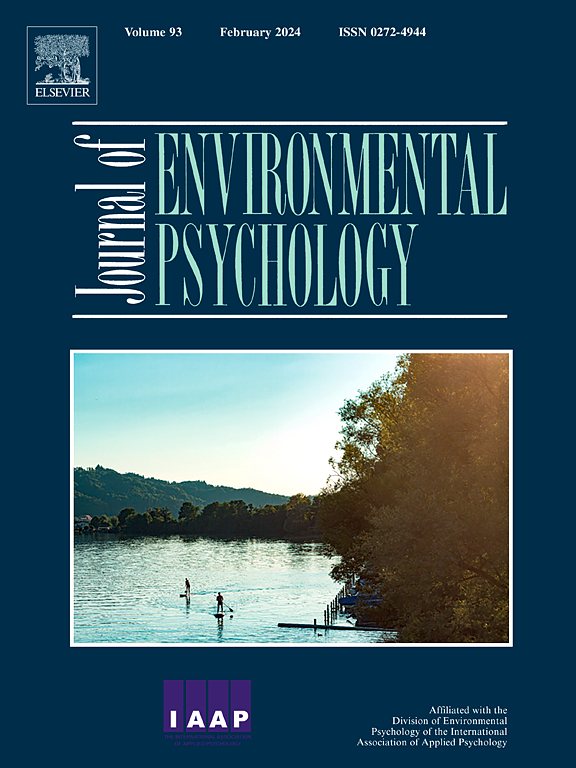Place attachment(s) and addiction to virtual places: A longitudinal analysis
IF 7
1区 心理学
Q1 ENVIRONMENTAL STUDIES
引用次数: 0
Abstract
While prior research has primarily examined relations between quality of real-life relationships and addiction to virtual places, the role of one's connection to physical environments remains unexplored. This study is the first to investigate whether different types of place attachment—the emotional and cognitive bond with physical spaces—predicts addiction to virtual places over time. We conducted a three-wave longitudinal panel survey (T1 = 1110, T2 = 434, T3 = 378) on a sample of Polish young adults (18–30), representative in terms of age, gender, and place of residence. We identified four distinct addiction trajectories through growth mixture modeling: low-stable, low-worsening, high-decreasing, and moderate-decreasing. Our findings reveal that active place attachment acts as a potential protective factor, being associated with the low-stable trajectory. In contrast, traditional attachment and relative place attachments were linked to the moderate-decreasing and high-decreasing trajectories, suggesting initially higher addiction levels and highlighting their potential role as risk factors for virtual addiction.
地点依恋与虚拟场所成瘾:纵向分析
虽然之前的研究主要研究了现实生活中人际关系的质量与虚拟环境成瘾之间的关系,但人们与现实环境的联系所起的作用仍未得到探索。这项研究首次调查了不同类型的地点依恋——与物理空间的情感和认知联系——是否预示着随着时间的推移对虚拟场所的上瘾。我们对年龄、性别和居住地具有代表性的波兰年轻人(18-30岁)样本进行了三波纵向面板调查(T1 = 1110, T2 = 434, T3 = 378)。我们通过生长混合模型确定了四种不同的成瘾轨迹:低稳定、低恶化、高减少和中度减少。我们的研究结果表明,活跃的地方依恋是一个潜在的保护因素,与低稳定的轨迹有关。相比之下,传统依恋和相对地点依恋与中度下降和高度下降轨迹相关,表明最初的成瘾水平较高,并突出了它们作为虚拟成瘾风险因素的潜在作用。
本文章由计算机程序翻译,如有差异,请以英文原文为准。
求助全文
约1分钟内获得全文
求助全文
来源期刊

Journal of Environmental Psychology
Multiple-
CiteScore
10.60
自引率
8.70%
发文量
140
审稿时长
62 days
期刊介绍:
The Journal of Environmental Psychology is the premier journal in the field, serving individuals in a wide range of disciplines who have an interest in the scientific study of the transactions and interrelationships between people and their surroundings (including built, social, natural and virtual environments, the use and abuse of nature and natural resources, and sustainability-related behavior). The journal publishes internationally contributed empirical studies and reviews of research on these topics that advance new insights. As an important forum for the field, the journal publishes some of the most influential papers in the discipline that reflect the scientific development of environmental psychology. Contributions on theoretical, methodological, and practical aspects of all human-environment interactions are welcome, along with innovative or interdisciplinary approaches that have a psychological emphasis. Research areas include: •Psychological and behavioral aspects of people and nature •Cognitive mapping, spatial cognition and wayfinding •Ecological consequences of human actions •Theories of place, place attachment, and place identity •Environmental risks and hazards: perception, behavior, and management •Perception and evaluation of buildings and natural landscapes •Effects of physical and natural settings on human cognition and health •Theories of proenvironmental behavior, norms, attitudes, and personality •Psychology of sustainability and climate change •Psychological aspects of resource management and crises •Social use of space: crowding, privacy, territoriality, personal space •Design of, and experiences related to, the physical aspects of workplaces, schools, residences, public buildings and public space
 求助内容:
求助内容: 应助结果提醒方式:
应助结果提醒方式:


